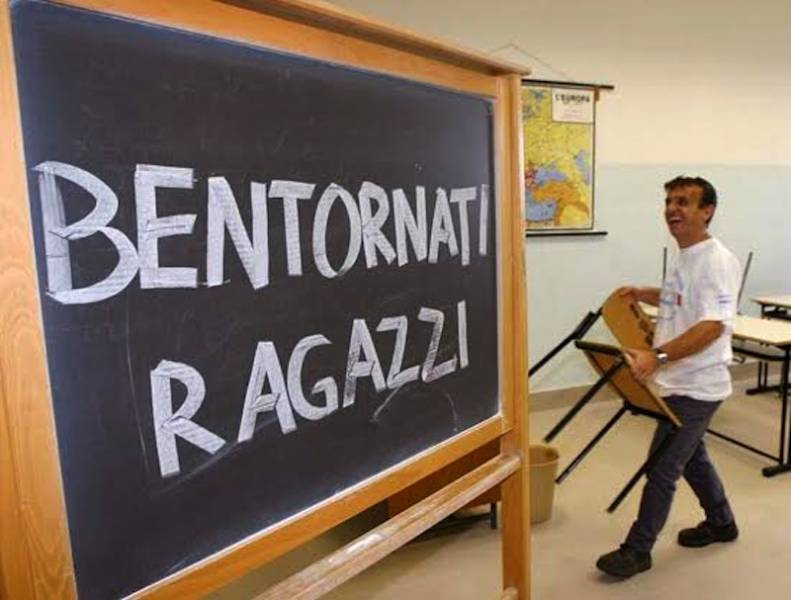Back to School Daze
This was back-to-school week for no less than ninety million young Italians, among them 216,000 with serious disabilities. With almost 1.2 million youngsters from pre-school through high school, Lombardy took first place among the regions for the largest number of students. But more important than the numbers is that this September marks the first test for the application of a modernizing school law passed by Parliament in July.
“This is the first step of schools taking a new role as a focal point of government attention,” said Education Minister Stefania Giannini. Still, a major objection to the reform bill is that teachers are being sent at some distance from their homes. But, put into action, most accepted transfer, albeit not for another year.
Premier Matteo Renzi has dubbed the reform “The Good School” (La Buona Scuola), and this is one of the successful reforms which the government of Matteo Renzi can boast about, even though, as the vote became finalized, both Minister for Constitutional Reform Maria Elena Boschi and Giannini were was assailed by the left wing of Renzi’s Partito Democratico, plus other parties and unions, especially but not only the teachers unions. In an effort to block the bill, over 2,600 amendments had been dragged into the debate, which nevertheless passed, 277 to 173 votes.
A pleased Renzi predicted that the new legislation will make the schools an “engine” for Italian development. (Renzi’s wife, coincidentally, is a teacher, and has not transferred with her husband to Rome but continued to teach Latin and Italian in a high school in Florence).
Those hired for temporary positions may be transferred to relatively distant schools, a factor which aggravates many. Above all teachers in the South of Italy are resisting transfer to schools in the North. However, in the Lazio Region around Rome 80% are accepting transfers before August 1916 and, in Turin, 60%.
In what is a true novelty for Italy, top performers will receive a merit bonus, thanks to the applicatio of evaluation criteria rather than automatic teaching career advancement, as applied until now. The ambitious new law aimed at updating an outmoded system also deals with the way teachers are hired and the educational preparation of teachers themselves.
To eliminate the waiting lists for positions that have sometimes lasted decades, some 100,000 teachers are to be given permanent positions; in order to become one of these, a docente di ruolo, the candidate must pass a competitive exam. Private sector funding is to be allowed, with individual schools competing against each other for private resources, even though this too is hotely contested as favoring the wealthier school districts (see: >>> ).
As in recent years, the new classes include a certain number of children of migrants. Indeed, in the Manzoni elementary school in Brescia two classes were made up of solely migrant children, without a single Italian in class. Each class of 17 and 18 students respectively had pupils from China, India, Moldavia, Pakistan and the Philippines. “Some have just arrived in Italy and don’t speak Italian,” Mario Maviglia, director for provincial schools, told a local newspaper. “We hope that we’ll get some help because otherwise we won’t be able to function. Perhaps a single school in the center of town where all the foreign children can go would be a good idea.”
Brescia is the North Italian city where 3,000 marched earlier this year asking for work permits for migrants. Their march was contested by right-wingers waving banners with slogans like “Brescia for the Bresciani, take back our city,” and wound up in a pitched battle with police. Addressing the Brescia situation, Matteo Salvini of the Northern League protested in a TV debate that there should be a maximum number of foreign students per class, “or there will be no integration of the foreigners, who will continue not to speak Italian.” One theory under discussion is that no more than 30% of students in any class should be non-Italians.
State schooling has existed since 1859, shortly after unification of Italy, but it was 1962 before education through middle school became obligatory for all. Only after 2004 was a nationwide test, which had been obligatory for entry into a high school, dropped. Today’s high school, also known as an upper secondary school, lasts five years, or up to age 19.
Despite the complaints you can hear on every street corner or in any school corridor, as of 2013 the Italian secondary school education was ranked twenty-first worldwide by an OECD-coordinated Programme for International Student Assessment – that is, Italy placed higher than the OECD average worldwide and higher than the United States.




































i-Italy
Facebook
Google+
This work may not be reproduced, in whole or in part, without prior written permission.
Questo lavoro non può essere riprodotto, in tutto o in parte, senza permesso scritto.